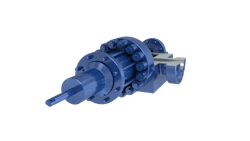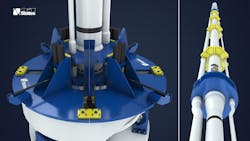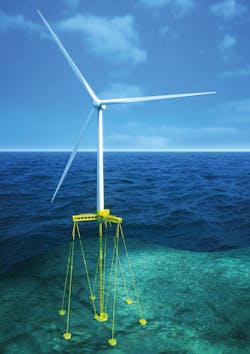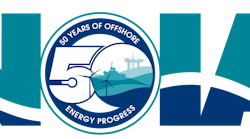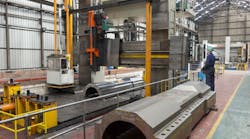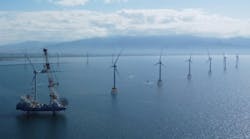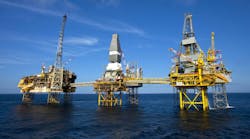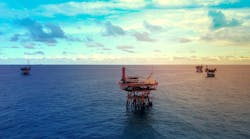Editor's note: This story first appeared in the September/October 2023 issue of Offshore magazine. Click here to view the full issue.
By Bruce Beaubouef, Managing Editor
As the offshore oil and gas marketplace surges into its latest upcycle, oilfield service companies and equipment providers find themselves needing to balance growing demands for traditional hydrocarbons with the needs of the energy transition.
After serving the oil and gas industry for 86 years, that is the situation that Oil States International, Inc., finds itself in. Originally founded as an oilfield supply store in Tulsa, Oklahoma, in 1937, Oil States has gone on to become a leading provider of connector systems, high-pressure riser systems, deepwater mooring systems, and subsea pipeline products to the international offshore oil and gas marketplace.
But in May 2022, seeing the trends in offshore wind energy and opportunities in deepsea mining, Oil States announced that it would be leveraging its oil and gas expertise to become a “multisource energy company.”
Offshore recently spoke with Cindy Taylor, Chief Executive Officer and President of Oil States, to get an update on this transformation process, both with regard to the company she helms and in the international energy marketplace at large.
Offshore: The offshore oil and gas market is as hot as it has been since (pre) 2014. What trends and opportunities do you see?
Taylor: Our long-term outlook for global energy demand growth remains optimistic given global population and per capita energy consumption trends. We envision that oil and gas will remain an essential part of the required lower-carbon mix of energy from all sources that will be needed to meet future demand. To support the development of these necessary resources, we have intentionally positioned ourselves to continue supporting our customers with technologies and services for traditional resources as well as for the development of lower-carbon energy sources.
Macro fundamentals remain strong, particularly in the offshore environment, and we see potential for a multi-year upcycle. Yet, near-term there are some unique facets of this upcycle that seem to differ from prior cycles. Oil price remains strong and there is an expectation of recovery in natural gas longer-term. According to EIA, Brent crude oil spot price averages $85/barrel in their August forecast. EIA also reported crude oil prices have increased since June, primarily because of extended voluntary cuts to Saudi Arabia’s crude oil production and increasing global demand. EIA expects these factors will continue to reduce global oil inventories and put upward pressure on oil prices in the coming months, with the Brent price averaging $86/barrel in the second half of 2023.
Normally these sustained oil price levels would begin to translate into an increase in US land-based rig count and frac crews with associated increases in drilling and completion activity. So far, however, we are seeing that completions activity levels have remained down from their peaks, perhaps reflective of sustained capital spending discipline by oil and gas operators in addition to lower commodity prices in effect in the first half of 2023. While rig count remains down from the peak and frac count also has trended downward following softness in natural gas basins, much of that equipment is mobile. We have not yet seen a significant uptick in activity in ‘oily’ basins despite the constructive oil price outlook through year end.
In contrast, offshore and international activity remains strong and continues to gain momentum – particularly in the major offshore basins like Brazil and Guyana as well as other offshore arenas. As a company with revenue exposure to offshore and international regions in addition to US land opportunities, we are now benefiting from growth in major offshore project activity globally. That has translated into continued growth in order intake coupled with an increasing backlog.
Offshore: Looking out over the next five years, what are the key challenges for the offshore oil and gas industry, and how will they be overcome? What are your clients telling you, in terms of their main concerns?
Taylor: Commodity prices, economic, and geopolitical factors, as well as shifts in supply and demand dynamics can lead to uncertain market conditions, which can have an impact on the industry’s profitability and investment decisions.
Increasing environmental regulations, particularly related to emissions and safety standards, pose ongoing challenges for the industry. Stricter regulations can require significant investment in technology and practices to ensure compliance.
The offshore oil and gas industry faces the dual challenge of replenishing oil and gas reserves necessary to fulfill global energy demand while simultaneously transitioning to a lower-carbon energy mix. Historic underinvestment in energy infrastructure can hinder this effort, potentially leading to production shortfalls and supply disruptions. To address this challenge, additional investment is required for upgrading and expanding energy infrastructure. Through further investment, the industry can maintain the necessary production levels while also facilitating the expansion of more sustainable energy sources. These investments are crucial not only for meeting energy demand but also for ensuring environmental sustainability and compliance with emissions reduction goals, which enhances the industry’s long-term viability.
As the energy mix changes and older infrastructure becomes obsolete, aging assets will require decommissioning. A growing number of wells require plug and abandonment at the end of their operational life or will need further investment to be utilized for carbon capture storage initiatives.
Another challenge the industry faces is attracting and retaining a skilled workforce. Our industry as a whole must do a better job of communicating the innovative technologies being created to advance lower-carbon energy production across multiple energy sources as well as the economic benefits for domestic and international communities. For instance, the US Department of Energy along with the Energy Workforce & Technology Council (of which we are active members) reported in July 2023 that while the pace of hiring in the energy industry continues to slow near-term, oilfield service jobs for the total sector remain steady at 665,016. These are good-paying jobs that contribute to families’ livelihoods and ensure access to reliable, affordable, and secure energy. This is a compelling mission that must be shared with our future workforce.
Offshore: At least three of the upcoming oil and gas developments in the deepwater Gulf of Mexico involve HP/HT reservoirs. Does the offshore industry have what it needs (technically) to develop and produce these reserves? What technical challenges remain? To what extent does the future of GoM E&P depend on the industry solving these challenges?
Taylor: High pressure/high temperature (HP/HT) wells are generally defined as ones with temperatures greater than 350 degrees Fahrenheit and pressures greater than 15,000 psi at the wellhead. These wells are more complex, involve greater risks and are more expensive to drill, complete and produce. Given these unique challenges, they are highly regulated by the Bureau of Ocean Energy Management and the Bureau of Safety and Environmental Enforcement. In the Gulf of Mexico, these wells are generally located in the Lower Tertiary and Jurassic Norphlet formations. Few wells are both high pressure and high temperature, but they all require high end, specialized equipment along with an intense regulatory and permitting process.While new wells are being evaluated, HP/HT wells have been successfully drilled and completed in the GoM already. The first high temperature well in the GoM was Shell’s Appomattox development which commenced production in 2019.
We and other service and manufacturing providers have designed equipment to meet the extreme operating conditions that will be encountered in these types of wells. Bottom hole pressures and temperatures can vary from what is observed at the wellhead. As a result, design parameters have to exceed what is expected in normal operating conditions. Given these factors, this high-end equipment is not readily available given its high cost and limited use in less demanding well conditions.
The GoM rig count totals 16 rigs operating as of August 18, 2023, compared to 176 rigs operating January 19, 2001 (according to the Baker Hughes rig count). These trends reflect the maturation of the GoM potential. Therefore, HP/HT wells need to be pursued in order for the US GoM to maintain its production levels over the longer term.
Offshore: Looking globally, what offshore areas do you think hold the most promise for the oil and gas industry?
Taylor: Westwood Energy forecasts 2023 offshore upstream engineering, procurement and construction (EPC) investment at $60.2 billion – and $20.1 billion of that had been awarded by the end of 2Q 2023. Westwood forecasts Africa and the Americas and the Middle East combined to represent 72% of that EPC spend. We also see a lot of opportunity for offshore in those regions.Brazil continues to drive strong demand for floating production infrastructure and technologies. Westwood noted that Petrobras continued with strong investments in floating production in 2022. Petrobras spent $10.2 billion for Buzios Phase VI-XI, with a substantial portion of that spend on FPSO installations.
Guyana saw great success last year, announcing 10 new finds. That included a record nine new discoveries in a calendar year within the Exxon Mobil-operated Stabroek Block and one in CGX’s Corentyne tract. Those discoveries added 99 million barrels of oil equivalent. The Kawa discovery, which is outside of Stabroek, opens up a new area of potential development with an estimated 1.8 billion barrels of oil equivalent that’s reportedly recoverable.
ExxonMobil has outlined exciting plans for Uaru, the next addition to the Stabroek developments in Guyana, which will involve 10 drill centers and 44 subsea injection and production wells. This undertaking will require additional infrastructure.
The floating production market drives demand for our FlexJoint connectors, riser systems, and subsea pipeline/SURF infrastructure, so all these developments continue to build our backlog. We’re poised to capitalize on this demand geographically and operationally with minimum expected capex as we have asset-light manufacturing and service centers around the globe in all the major offshore basins.
Continued subsea tieback activity as well as the larger HP/HT developments I previously mentioned also remain a bright spot in offshore activity.
Westwood reported in April that an unprecedented level of investment in the offshore GCC [editor’s note: the Gulf Cooperation Council countries of Kuwait, Oman, Saudi Arabia and the UAE] market is expected this year through 2027 in response to local NOC’s increasing production capacities. Spending is forecast to increase 27% compared to 2019-22. In addition to offshore floating facilities, spending in the Middle East on jackup drilling and fixed platform installations continues to grow. This presents a great opportunity for us as it drives demand for our HP riser systems and fixed platform technologies.
We’re also seeing HP/HT opportunities in Australia and Asia fueled by shallow-water developments which are not economically attractive to drill with a higher cost semi-sub. Our team has recently developed a new Merlin 15K HP/HT riser system which enables more cost-effective drilling of HP/HT wells from a jackup rig. We believe this is the first system like this in the world that is qualified both for HP/HT as well as sour service applications which are common in Australia and Asia, and we are seeing opportunities for both rental and sale of the systems.
Offshore: In May 2022, Oil States announced that it would be leveraging its oil and gas expertise to become a “multisource energy company.” Can you talk about what led the company to pursue this path, and how it has gone to date? What have been the biggest challenges and accomplishments in this transformation process?
Taylor: One of the primary challenges for companies of our size is to continue to support our existing customers with optimized services and high-end technology equipment (both for new equipment designs and R&D) while also investing in engineering, research, development, new equipment and services in support of emerging technologies aimed at global decarbonization.
Oil and gas remain key contributors to the energy industry and will for the foreseeable future as the energy industry expands and becomes increasingly diversified.
What many people do not realize is that oil and gas technologies and the industry’s workforce are helping to solve some of the most difficult challenges certain alternative energy sources face, in order to grow.
As the demands of offshore wind farms are increasingly beyond the cost-effective limit for monopiles and jacket structures, next-generation platform technology is necessary to optimize the potential of this energy source.
It’s designed for water depths up to 150 meters and wave heights averaging up to 10 meters, which greatly expands opportunities for offshore wind development in deeper waters to help meet a portion of the demand for the 26,500 offshore wind turbines Westwood has forecast over the next seven years.
The FTLP can also be built locally, satisfying local content requirements and potentially eliminating the costly quayside reinforcement that can be a deterrent for these projects.
Oil States has also leveraged its ultra-deepwater riser expertise to advance deepsea mineral mining. This is a very important development as demand for seabed minerals is expected to grow substantially as the US and Europe encourage the adoption of electric cars and other alternative energy technologies.
Our Merlin Deepsea Mineral Riser was part of a successful project with The Metals Company and Allseas which resulted in over 3,000 tons of polymetallic nodules being harvested from the seabed floor last year. These important technologies demonstrate our innovation and important contributions to this space, and gives just a glimpse of the critical role oil and gas plays in the energy continuum.
Offshore: There has been much discussion about the possibilities for floating offshore wind platforms. Where is the industry in this process? Are floating wind platforms market-ready, from an engineering point of view? How much does the future of the offshore wind market depend on the industry solving the challenge of designing and building a floating wind platform?
Taylor: The 26,500 wind platforms that are projected to be installed over the next seven years is an aggressive target. It’s imperative for offshore wind to be able to move into deeper waters – the winds are stronger and it opens up entirely new markets. A floating wind platform is key to accomplishing this.
With deeper waters come more intense waves and weather, which is hard on turbines. Our FTLP has less than one degree of declination or movement in the platform compared to much more unstable, truly floating TLP-style platforms. Reducing movement extends the life of the turbines, which improves costs. Our FTLP is still in development and as we’re targeting our first installation for 2025/2026, we’re actively exploring pilot projects now.
Offshore: There is much interest in the possibilities of deepsea mining, but there is also much uncertainty about the international regulations and the environmental impact. Can these critical minerals be mined with minimal impact on marine biodiversity?
Taylor: It’s important to recognize that every energy source has an impact on its surrounding environment – offshore wind, for example, impacts marine species. The goal is to continuously identify ways to minimize impact; continuously improve.
The geopolitical realities we face and the limits of onshore mining make deepsea mining an attractive option. The regulatory context for deepsea minerals mining is still evolving – the UN’s International Seabed Authority is developing a “mining code” that is still largely in draft stage. There also remains a need to increase awareness about the important advantages of collaboration between a private contractor and a sponsoring state for the purposes of an ISA Exploration Contract.
If Net Zero is the global goal, mineral mining is critical to this end – and those minerals have to be sourced in some way. We believe that the characteristics of polymetallic nodules provide an opportunity to compress environmental and social impacts of producing these irreplaceable metals, offering the cleanest path toward expanding the use of alternative energy technologies.
Offshore: There’s been a growing amount of controversy and pushback regarding the ESG movement—the impact it’s had on available capital, corporate governance, and oil and gas production in general. What is your view of these trends, and how have you dealt with it at Oil States?
Taylor: The principals of ESG have been largely aspirational to date. As we progress to tactical implementation, many roadblocks and issues have surfaced. These issues are broad and include technology limitations; environmental impacts that are not well understood; supply chain needs that are significantly greater than anyone envisioned; high cost of deployment even with subsidies considered; and extensive use of (and destruction of) land and rain forests. In addition, capital to fund potentially trillions of dollars of investment is not currently available.
As it relates to capital access and to governance considerations, many investment firms, banks and rating agencies were quick to implement processes to “rate” or evaluate ESG as part of their investing and lending strategies. I believe that these efforts got ahead of the studies and quality data needed to make valuable contributions to the process. Now that some of these limitations have been exposed, there has been a simultaneous re-assessment of the role that ESG should play in these matters, at least for the near term.
One thing is certain, it is going to take all energy sources to meet the world’s energy demand.
Offshore: To your mind, what are some of the reasonable, feasible steps that the oil and gas industry can take, or is taking, to reduce its carbon footprint?
Taylor: The oil and gas industry continues to make significant strides that make it more sustainable. Remanufactured parts and rebuilds reduce the amount of waste and also reduces the amount of materials and energy necessary to manufacture new components and equipment. Technologies that reduce fuel consumption by default reduce emissions. Using alternative fuels, such as natural gas, to power oil and gas production also reduces emissions. Determining if mature wells can be repurposed for carbon capture and storage reduces carbon footprint. New technologies are continuously introduced that further lower emissions.
As a company, reducing our internal emissions is a strong priority in the reduction of Scope 1 emissions. We have continued to reduce our already low carbon emissions footprint through a focus on things like fleet vehicle usage and idling policies.
For Scope 2 emissions, we are assessing our global sourcing of power to run our manufacturing facilities and looking at the cleanest electric providers available. Our installation of solar panels in Scotland is one example of the measures we’re taking to manage our Scope 2 emissions.
There is evolving thought and interest around the concept of Scope 4 emissions reductions. What this concept means is that we can design efficiencies in our equipment that reduce the carbon emissions of our customers. In doing so, companies should get emissions credits.
Offshore: What is your view of the energy transition, and its related goals and policies? Is Net Zero by 2050 realistic?
Taylor: My own view is that “Net Zero” is poorly defined and extremely difficult to achieve. Today, about 82% of global energy is sourced from nonrenewable sources such as oil, natural gas, and coal. Replacing that high of a percentage on a global scale will not be achieved by 2050, if ever. If we get close to such an aspirational target, it is likely to rely on green credits or offsets rather than on the elimination of conventional sources of energy that we use today. Furthermore, nearly 90% of the global population does not enjoy the lifestyle and benefits afforded by secure, reliable and affordable energy as we and other developed economies do. As their populations grow and their economies advance, they will undoubtedly consume more energy on a per capita basis.
Funding the scope and scale of infrastructure investment needed to affect such a massive transition will require capital of a scale that no one has seen before. Less developed, poor countries do not have the resources to invest in such a transition. Developed countries refuse to balance their own budgets and are amassing debt at an alarming rate. Given this macro backdrop, needed infrastructure investment is likely to be crowded out by social spending and entitlements.
If climate change is truly the imminent disaster that it is made out to be, the likely only solution is to reduce consumption and adjust lifestyles back to a level that will be very difficult for people to accept.

